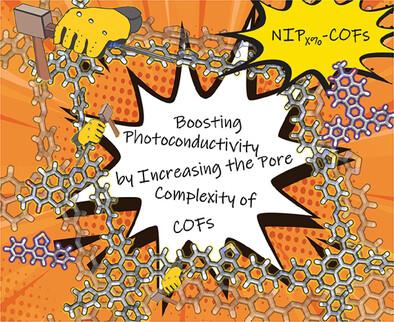Our official English website, www.x-mol.net, welcomes your
feedback! (Note: you will need to create a separate account there.)
Boosting Photoconductivity by Increasing the Structural Complexity of Multivariate Covalent Organic Frameworks
Small ( IF 13.0 ) Pub Date : 2024-11-20 , DOI: 10.1002/smll.202406211 Marta Gordo‐Lozano, Marcos Martínez‐Fernández, Rajendra Prasad Paitandi, José I. Martínez, José L. Segura, Shu Seki
Small ( IF 13.0 ) Pub Date : 2024-11-20 , DOI: 10.1002/smll.202406211 Marta Gordo‐Lozano, Marcos Martínez‐Fernández, Rajendra Prasad Paitandi, José I. Martínez, José L. Segura, Shu Seki

|
The assessment of the photoconductivity of Donor‐Acceptor (D‐A) ordered bulk heterojunctions is gaining attention for the development of innovative organic semiconductors in optoelectronics. Here, the synthesis of pyrene‐based (D) Covalent Organic Frameworks, achieve through a multivariate reaction involving two distinct acceptors is reported (A). The products are characterized using powder x‐ray diffraction, N2 sorption isotherms, electronic microscopy, and in silico calculations, among other techniques. These characterizations reveal that the multicomponent synthesis enables the modification of properties (e.g., bandgap) of the framework while preserving its structural features, such as crystallinity and porosity. The ordered D‐A arrays position these materials as promising candidates for photoconductive semiconductors, particularly regarding the variation in the composition of isotopological frameworks. Photoconductivity experiments demonstrate a volcano‐type correlation with respect to the A moiety content, with the optimal value reaching 7.9 × 10−5 cm2 V−1 s−1 for the bare NIP25% ‐COF. This study illustrates how introducing diverse acceptor units through multivariate synthesis can enhance the photoconductivity of these materials via “defect” engineering, without sacrificing their crystalline or porous characteristics and avoiding the need for de novo synthesis.
中文翻译:

通过增加多元共价有机框架的结构复杂性来提高光电导性
对供体-受体 (D-A) 有序体异质结的光电导率评估在光电子学中创新有机半导体的开发中越来越受到关注。在这里,报道了通过涉及两个不同受体的多变量反应实现的基于芘基 (D) 共价有机框架的合成 (A)。使用粉末 X 射线衍射、N2 吸附等温线、电子显微镜和计算机计算等技术对产物进行表征。这些表征表明,多组分合成能够改变框架的性质(例如带隙),同时保留其结构特征,例如结晶度和孔隙率。有序的 D-A 阵列将这些材料定位为光电导半导体的有前途的候选材料,特别是关于同位素框架组成的变化。光电导实验表明,关于 A 部分含量存在火山型相关性,对于裸露的 NIP25%-COF,最佳值达到 7.9 × 10-5 cm2 V-1 s-1。本研究说明了通过多变量合成引入不同的受体单元如何通过“缺陷”工程增强这些材料的光电导性,而不会牺牲它们的晶体或多孔特性,也无需从头合成。
更新日期:2024-11-20
中文翻译:

通过增加多元共价有机框架的结构复杂性来提高光电导性
对供体-受体 (D-A) 有序体异质结的光电导率评估在光电子学中创新有机半导体的开发中越来越受到关注。在这里,报道了通过涉及两个不同受体的多变量反应实现的基于芘基 (D) 共价有机框架的合成 (A)。使用粉末 X 射线衍射、N2 吸附等温线、电子显微镜和计算机计算等技术对产物进行表征。这些表征表明,多组分合成能够改变框架的性质(例如带隙),同时保留其结构特征,例如结晶度和孔隙率。有序的 D-A 阵列将这些材料定位为光电导半导体的有前途的候选材料,特别是关于同位素框架组成的变化。光电导实验表明,关于 A 部分含量存在火山型相关性,对于裸露的 NIP25%-COF,最佳值达到 7.9 × 10-5 cm2 V-1 s-1。本研究说明了通过多变量合成引入不同的受体单元如何通过“缺陷”工程增强这些材料的光电导性,而不会牺牲它们的晶体或多孔特性,也无需从头合成。


















































 京公网安备 11010802027423号
京公网安备 11010802027423号